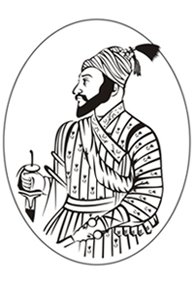The next sketch shows Shivaji deliberating with the members of his Ashtha Pradhan or the Council of Eight Ministers. It was formally created at the time of his Coronation Ceremony held on 6th June 1674. The choice of the term Ashtha Pradhan for his Council of Ministers was significant. In none of the Rajput States, some of which had been in existence since the 8th century, for instance Mewar, had there been a Council of Ministers with such a title. The painting shows Moro Trimbak Pingle, the Mukhya Pradhan or Peshwa (Prime Minister), Ramchandra Nilkantha, the Amatya (incharge of public income and expenditure or Revenue Minister), Annaji Datto, the Sachiv (Surnis or incharge of Royal correspondence), and Dattaji Trimbak, the Mantri (Personal advisor who also kept a record of the Kings doings and Court incidents) on the right side of the throne. On the left side are Senapati Hambir Rao Mohite, Ramchandra Trimbak the Sumant (Foreign Minister), Raoji Niraji, the Nyayadhish or the Chief Judge, and Raghunath Pandit, the Panditrao and incharge of religious matters.
The creation of the Council of Ministers not only shows Shivaji's methodical mind and administrative genius but also his desire to build his Swarajya on broad and solid foundations not deficient in an effective machinery for meeting the growing demands of different branches of the administration, and not merely a 'State' living on war and plunder.
The creation of the Council of Ministers not only shows Shivaji's methodical mind and administrative genius but also his desire to build his Swarajya on broad and solid foundations not deficient in an effective machinery for meeting the growing demands of different branches of the administration, and not merely a 'State' living on war and plunder.

